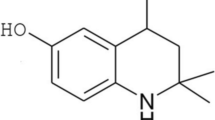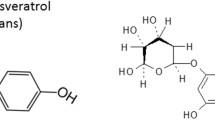Abstract
The study aimed to investigate the involvement of nitric oxide (NO) in maneb (MB)- and paraquat (PQ)-induced Parkinson’s disease (PD) phenotype in mouse and its subsequent contribution to lipid peroxidation. Animals were treated intraperitoneally with or without MB and PQ, twice a week for 3, 6 and 9 weeks. In some sets of experiments (9 weeks treated groups), the animals were treated intraperitoneally with or without inducible nitric oxide synthase (iNOS) inhibitor-aminoguanidine, tyrosine kinase inhibitor-genistein, nuclear factor-kappa B (NF-kB) inhibitor-pyrrolidine dithiocarbamate (PDTC) or p38 mitogen activated protein kinase (MAPK) inhibitor-SB202190. Nitrite content and lipid peroxidation were measured in all treated groups along with respective controls. RNA was isolated from the striatum of control and treated mice and reverse transcribed into cDNA. RT-PCR was performed to amplify iNOS mRNA and western blot analysis was done to check its protein level. MB- and PQ-treatment induced nitrite content, expressions of iNOS mRNA and protein and lipid peroxidation as compared with respective controls. Aminoguanidine resulted in a significant attenuation of iNOS mRNA expression, nitrite content and lipid peroxidation demonstrating the involvement of nitric oxide in MB- and PQ-induced lipid peroxidation. Genistein, SB202190 and PDTC reduced the expression of iNOS mRNA, nitrite content and lipid peroxidation in MB- and PQ-treated mouse striatum. The results obtained demonstrate that nitric oxide contributes to an increase of MB- and PQ-induced lipid peroxidation in mouse striatum and tyrosine kinase, p38 MAPK and NF-kB regulate iNOS expression.




Similar content being viewed by others
References
Marsden CD (1990) Parkinson’s disease. Lancet 335:948–952
Albin RL, Young AB, Penney JB (1989) The functional anatomy of basal ganglia disorders. Trends Neurosci 12:366–375
Singh MP, Patel S, Dikshit M et al (2006) Contribution of genomics and proteomics in understanding the role of modifying factors in Parkinson’s disease. Indian J Biochem Biophys 43:69–81
Singh C, Ahmad I, Kumar A (2007) Pesticides and metals induced Parkinson’s disease: involvement of free radicals and oxidative stress. Cell Mol Biol 53:19–28
Thiruchelvam M, Brockel BJ, Richfield EK et al (2000) Potentiated and preferential effects of combined paraquat and maneb on nigrostriatal dopamine systems: environmental risk factors for Parkinson’s disease? Brain Res 873:225–234
Cory-Slechta DA, Thiruchelvam M, Barlow BK et al (2005) Developmental pesticide models of the Parkinson disease phenotype. Environ Health Perspect 113:1263–1270
Patel S, Singh V, Kumar A et al (2006) Status of antioxidant defense system and expression of toxicant responsive genes in striatum of maneb-and paraquat-induced Parkinson’s disease phenotype in mouse: mechanism of neurodegeneration. Brain Res 1081:9–18
Kappus H (1986) Overview of enzyme systems involved in bio-reduction of drugs and in redox cycling. Biochem Pharmacol 35:1–6
Gragus Z, Klaassen CD (1996) Mechanisms of toxicity. In: Klaassen CD, Andur MO, Doull J (eds) Casarett and Doulls toxicology. The basic science of poisons. Macmillan, New York, pp 41–48
Beckman JS, Beckman TW, Chen J et al (1990) Apparent hydroxyl radical production by peroxynitrite: implications for endothelial injury from nitric oxide and superoxide. Proc Natl Acad Sci USA 87:1620–1624
Zhang J, Fitsanakis VA, Gu G et al (2003) Manganese ethylene-bis-dithiocarbamate and selective dopaminergic neurodegeneration in rat: a link through mitochondrial dysfunction. J Neurochem 84:336–346
Brooks AI, Chadwick CA, Gelbard HA et al (1999) Paraquat elicited neurobehavioral syndrome caused by dopaminergic neuron loss. Brain Res 823:1–10
McCormack AL, Thiruchelvam M, Manning-Bog AB et al (2002) Environmental risk factors and Parkinson’s disease: selective degeneration of nigral dopaminergic neurons caused by the herbicide paraquat. Neurobiol Dis 10:119–127
Thiruchelvam M, Richfield EK, Baggs RB et al (2000) The nigrostriatal dopaminergic system as a preferential target of repeated exposures to combined paraquat and maneb: implications for Parkinson’s disease. J Neurosci 20:9207–9214
Patel S, Sinha A, Singh MP (2007) Identification of differentially expressed proteins in striatum of maneb-and paraquat-induced Parkinson’s disease phenotype in mouse. Neurotoxicol Teratol 29:578–585
Patel S, Singh K, Singh S et al (2008) Gene expression profiles of mouse striatum in control and maneb + paraquat-induced Parkinson’s disease phenotype: validation of differentially expressed energy metabolizing transcripts. Mol Biotechnol 40:59–68
Beckman JS (1996) Oxidative damage and tyrosine nitration from peroxynitrite. Chem Res Toxicol 9:836–844
Pryor WA, Squadrito GL (1995) The chemistry of peroxynitrite a product from the reaction of nitric oxide with superoxide. Am J Physiol 268:L699–L722
Dawson VL, Dawson TM (1998) Nitric oxide in neurodegeneration. Prog Brain Res 118:215–229
Zhang L, Dawson VL, Dawson TM (2006) Role of nitric oxide in Parkinson’s disease. Pharmacol Ther 109:33–41
Liberatore GT, Jackson-Lewis V, Vukosavic S et al (1999) Inducible nitric oxide synthase stimulates dopaminergic neurodegeneration in the MPTP model of Parkinson disease. Nat Med 5:1403–1409
Paul A, Pendreigh RH, Plevin R (1995) Protein kinase C and tyrosine kinase pathways regulate lipopolysaccharide-induced nitric oxide synthase activity in RAW 264.7 murine macrophages. Br J Pharmacol 114:482–488
Xu Z, Wang B, Wang X et al (2006) ERK1/2 and p38 mitogen-activated protein kinase mediate iNOS-induced spinal neuron degeneration after acute traumatic spinal cord injury. Life Sci 79:1895–1905
Koppal T, Drake J, Yatin S et al (1999) Peroxynitrite-induced alterations in synaptosomal membrane proteins: insights into oxidative stress in Alzheimer’s disease. J Neurochem 72:310–317
Liu W, Kato M, Itoigawa M et al (2001) Distinct involvement of NF-kB and p38 mitogen-activated protein kinase pathways in serum deprivation-mediated stimulation of inducible nitric oxide synthase and its inhibition by 4-hydroxynonenal. J Cell Biochem 83:271–280
Karpuzoglu E, Fenaux JB, Phillips RA et al (2006) Estrogen up-regulates inducible nitric oxide synthase, nitric oxide, and cyclooxygenase-2 in splenocytes activated with T cell stimulants: role of interferon-gamma. Endocrinology 147:662–671
Fan Q, Ding J, Zhang J et al (2004) Effect of the knockdown of podocin mRNA on nephrin and α-actinin in mouse podocyte. Exp Biol Med 229:964–970
Martin PY, Bianchi M, Roger F et al (2002) Arginine vasopressin modulates expression of neuronal NOS in rat renal medulla. Am J Physiol Renal Physiol 283:F559–F568
Bradford MM (1976) A rapid and sensitive method for the quantitation of microgram quantities of protein utilizing the principle of protein-dye binding. Anal Biochem 72:248–254
Granger DL, Taintor RR, Boockvar KS, Hibbs JB (1996) Measurement of nitrate and nitrite in biological samples using nitrate reductase and Greiss reaction. Methods Enzymol 268:142–151
Ohkawa H, Ohishi N, Yagi K (1979) Assay for lipid peroxides in animal tissues by thiobarbituric acid reaction. Anal Biochem 95:351–358
Singh S, Singh K, Patel DK et al (2009) The expression of CYP2D22, an ortholog of human CYP2D6, in mouse striatum and its modulation in MPTP-induced Parkinson’s disease phenotype and nicotine-mediated neuroprotection. Rejuvenation Res 12:185–197
Singh AK, Tiwari MN, Upadhyay G et al (2010) Long term exposure to cypermethrin induces the nigrostriatal dopaminergic neurodegeneration in adult rats: postnatal exposure enhances the susceptibility during adulthood. Neurobiol Aging. doi:10.1016/j.neurobiolaging.2010.02.018
Ischiropoulos H, Al-Mehdi AB (1995) Peroxynitrite-mediated oxidative protein modifications. FEBS Lett 364:279–282
Przedborski S, Jackson-Lewis V, Djaldetti R et al (2000) The parkinsonian toxin MPTP: action and mechanism. Restor Neurol Neurosci 16:135–142
Torreilles F, Salman-Tabcheh S, Guerin M, Torreilles J (1999) Neurodegenerative disorders: the role of peroxynitrite. Brain Res Rev 30:153–163
Okuno T, Nakatsuji Y, Kumanogoh A et al (2005) Loss of dopaminergic neurons by the induction of inducible nitric oxide synthase and cyclooxygenase-2 via CD40: relevance to Parkinson’s disease. J Neurosci Res 81:874–882
Knott C, Stern G, Wilkin GP (2000) Inflammatory regulators in Parkinson’s disease: iNOS, lipocortin-I and cyclooxygenases-1 and -2. Mol Cell Neurosci 16:724–739
Bus JS, Gibson JE (1984) Paraquat: model for oxidant-initiated toxicity. Environ Health Perspect 55:37–46
Cohen GM, d’Arcy Doherty M (1987) Free radical mediated cell toxicity by redox cycling chemicals. Br J Cancer Suppl 8:46–52
Good PF, Hsu A, Werner P et al (1998) Protein nitration in Parkinson’s disease. J Neurophathol Exp Neurol 57:338–342
Dehmer T, Lindenau J, Haid S et al (2000) Deficiency of inducible nitric oxide synthase protects against MPTP toxicity in vivo. J Neurochem 74:2213–2216
Chen YQ, Fisher JH, Wang MH (1998) Activation of the RON receptor tyrosine Kinase inhibits inducible nitric oxide synthase (iNOS) expression by murine peritoneal exudate macrophages: phosphatidylinositol-3 kinase is required for RON-mediated inhibition of iNOS expression. J Immun 161:4950–4959
Noack H, Possel H, Rethfeldt C et al (1999) Peroxynitrite mediated damage and lowered superoxide tolerance in primary cortical glial cultures after induction of the inducible isoform of NOS. Glia 28:13–24
Denicola A, Radi R (2005) Peroxynitrite and drug-dependent toxicity. Toxicology 208:273–288
Antunes F, Nunes C, Laranjinha J, Cadenas E (2005) Redox interactions of nitric oxide with dopamine and its derivatives. Toxicology 208:207–212
Brown GC (1999) Nitric oxide and mitochondrial respiration. Biochim Biophys Acta 1411:351–369
Violi F, Marino R, Milite MT, Loffredo L (1999) Nitric oxide and its role in lipid peroxidation. Diabetes Metab Res Rev 15:283–288
Giardino I, Fard AK, Hatchell DL, Brownlee M (1998) Aminoguanidine inhibits reactive oxygen species formation, lipid peroxidation, and oxidant-induced apoptosis. Diabetes 47:1114–1120
Kedziora-Kornatowska KZ, Luciak M, Blaszczyk J, Pawlak W (1998) Effect of aminoguanidine on the generation of superoxide anion and nitric oxide by peripheral blood granulocytes of rats with streptozotocin-induced diabetes. Clin Chim Acta 278:45–53
Courderot-Masuyer C, Dalloz F, Maupoil V, Rochette L (1999) Antioxidant properties of aminoguanidine. Fundan Clin Pharmacol 13:535–540
Tsang AH, Lee YI, Ko HS et al (2009) S-nitrosylation of XIAP compromises neuronal survival in Parkinson’s disease. ProcNatl Acad Sci USA 106:4900–4905
Padovan-Neto FE, Echeverry MB, Tumas V et al (2009) Nitric oxide synthase inhibition attenuates L-DOPA-induced dyskinesias in a rodent model of Parkinson’s disease. Neuroscience 159:927–935
Vallance P, Leiper J (2002) Blocking NO synthesis: how, where and why? Nat Rev Drug Discov 1:939–950
Kong LY, McMillian MK, Maronpot R, Hong JS (1996) Protein tyrosine kinase inhibitors suppress the production of nitric oxide in mixed glia, microglia-enriched or astrocyte-enriched cultures. Brain Res 729:102–109
Jeohn GH, Cooper CL, Wilson B et al (2002) p38 MAP kinase is involved in lipopolysaccharide-induced dopaminergic neuronal cell death in rat mesencephalic neuron-glia cultures. Ann NY Acad Sci 962:332–346
Acknowledgments
The authors sincerely thank Department of Biotechnology (DBT) for the financial support of the study. Authors acknowledge Council of Scientific and Industrial Research (CSIR), New Delhi, India for providing research fellowships to Suman Patel, Sharawan Yadav and Anand Kumar Singh. Authors also thank University Grants Commission (UGC), New Delhi, India for providing research fellowship to Seema Singh. The IITR communication number of this article is 2780.
Author information
Authors and Affiliations
Corresponding author
Additional information
Satya Prakash Gupta and Suman Patel have contributed equally to this work.
Rights and permissions
About this article
Cite this article
Gupta, S.P., Patel, S., Yadav, S. et al. Involvement of Nitric Oxide in Maneb- and Paraquat-Induced Parkinson’s Disease Phenotype in Mouse: Is There Any Link with Lipid Peroxidation?. Neurochem Res 35, 1206–1213 (2010). https://doi.org/10.1007/s11064-010-0176-5
Accepted:
Published:
Issue Date:
DOI: https://doi.org/10.1007/s11064-010-0176-5




